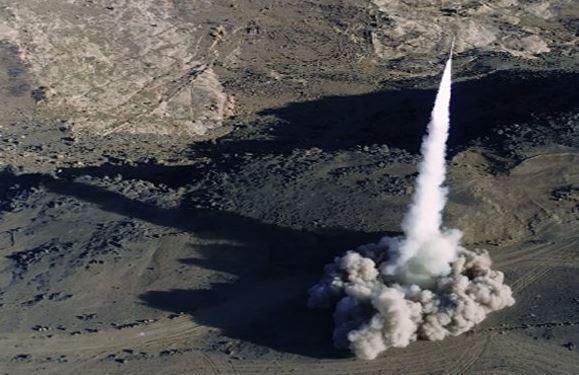The Israeli military reported that a missile fired from Yemen crossed into central Israel on Sunday, landing in an open area without causing any injuries. The incident has further heightened regional tensions, which have been escalating over the past year due to the ongoing Gaza war.
Following the missile’s impact, photographers from AFP captured images of firefighters extinguishing a brush fire near Lod and damage to glass at a train station in Modiin, southeast of Tel Aviv, Israel’s commercial and financial hub.
Although Yemen’s Huthi rebels did not immediately claim responsibility for the missile attack, the group is known to be among the Iran-backed factions involved in the broader Middle East conflict triggered by the October 7 Hamas attack on Israel. The Huthis, along with other Tehran-aligned militant groups in Iraq, Syria, and Lebanon, have been active participants in this growing regional instability.
In a statement, Israel’s military confirmed that “a surface-to-surface missile was identified crossing into central Israel from the East and fell in an open area. No injuries were reported.” Later, the military added that the missile had been launched from Yemen.
The attack follows a Huthi drone strike in July, which successfully breached Israel’s air defenses and resulted in the death of a civilian in Tel Aviv, roughly 1,800 kilometers (1,200 miles) from Yemen.
Sunday’s missile strike underscores the continued involvement of the Huthi rebels in targeting Israel as an expression of solidarity with Palestinians amid the ongoing conflict in Gaza. The Huthis are part of an “axis of resistance” that includes Hezbollah and other groups aligned with Iran.
Escalating Tensions in the Region
The Huthis have been launching missile and drone strikes not only on Israel but also on shipping lanes in the Gulf of Aden and the Red Sea since November. These attacks have disrupted vital global trade routes and resulted in fatalities, including several Filipino sailors. American military forces have retaliated against Huthi targets following these assaults.
Last month, Huthi missiles hit a Greek-flagged tanker off the coast of Hodeida, Yemen, igniting a fire and sparking fears of an environmental catastrophe. Salvage operations are still underway for the stricken vessel, which is being escorted under military supervision.
In response to the Huthis’ deadly July strike on Tel Aviv, Israeli warplanes bombed the Huthi-controlled port city of Hodeida, severely damaging the region’s fuel storage facilities and killing several people. This was Israel’s first confirmed strike in Yemen, marking a new phase in the broader conflict.
Northern Front Tensions
Meanwhile, tensions also remain high on Israel’s northern border. Hezbollah, another Iran-aligned group, has been engaging in cross-border exchanges with Israeli forces, particularly along the Lebanon-Israel frontier and in the Golan Heights. On Sunday morning, the Israeli military reported that about 40 projectiles had been launched from Lebanon into Israel’s Upper Galilee and the Golan Heights. These frequent clashes have already displaced tens of thousands of civilians on both sides of the border.
Internal Unrest in Israel
As the conflict rages, domestic unrest has also intensified. Thousands of Israelis took to the streets on Saturday to demand that the government do more to secure the release of hostages held in Gaza. The war, which began with a Hamas attack that killed over 1,200 people in Israel, has resulted in the deaths of more than 41,000 people in Gaza, according to the Hamas-run health ministry.
Despite ongoing efforts by Qatari, Egyptian, and U.S. mediators, no breakthrough has been achieved in securing a truce or a hostage release deal. Prime Minister Benjamin Netanyahu faces growing criticism from both the public and political rivals for not doing enough to bring the captives home.
The regional tensions, compounded by rising domestic pressure, leave the Middle East on the brink of further escalation as international efforts to mediate a resolution remain stalled.
Here are the key points from the article:
- Missile from Yemen: A missile fired from Yemen crossed into central Israel, causing no injuries but increasing regional tensions amid the ongoing Gaza war.
- Locations Impacted: The missile caused a brush fire near Lod and damaged glass at a train station in Modiin, southeast of Tel Aviv.
- Huthi Rebels’ Involvement: While Yemen’s Huthi rebels did not immediately claim the attack, they are part of the Iran-backed groups drawn into the Israel-Hamas conflict since the October 7 attack on Israel.
- Previous Huthi Strike: In July, the Huthis claimed a drone strike that breached Israel’s defenses, killing a civilian in Tel Aviv.
- Israel’s Military Statement: Israel’s military confirmed the missile was fired from Yemen and landed in an open area. Air-defense interceptors were deployed during the incident.
- Huthi Attacks on Shipping: Since November, the Huthis have launched missile and drone strikes on shipping in the Gulf of Aden and the Red Sea, resulting in fatalities and environmental concerns.
- Israeli Retaliation: Israel retaliated for a Huthi strike in July by bombing Huthi-controlled Hodeida, marking Israel’s first strike in Yemen.
- Northern Border Tensions: Hezbollah continues cross-border exchanges with Israel from Lebanon, escalating tensions in Israel’s northern region.
- Protests in Israel: Thousands of Israelis protested, demanding more efforts from the government to secure the release of hostages held in Gaza amid the ongoing conflict.



